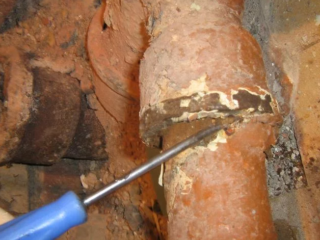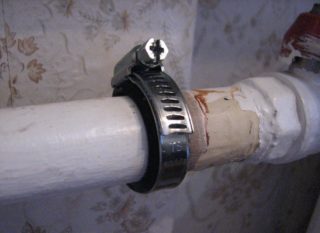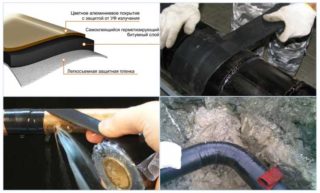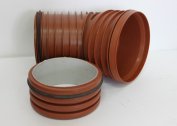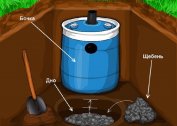The situation when the cast-iron sewer pipe burst is quite common. To quickly eliminate a leak, it is not necessary to involve specialists. A similar problem can be dealt with at home using simple methods.
Causes of Damage
Holes in sewer pipes made of cast iron mainly appear at the locations of joints, joints of individual elements of the system. They can also form on bends at a right angle. Leaks are also localized at the areas where the pipeline is connected to various equipment - collectors, a toilet, a washbasin, and viewing windows.
The causes of cracks in the cast-iron elements of the sewer:
- natural wear - relevant for old houses, where the recommended pipe life is significantly exceeded;
- metal corrosion that occurs when it interacts with oxygen;
- insufficient sealing of joints;
- improper operation of pipelines when they are subjected to intense mechanical stress, shock;
- manufacturing defects.
Repair of a cast-iron sewer pipe will be needed if mistakes are made in the design and installation of the system. With underground laying, cracks appear when communications are too close to the freezing line of the soil. This leads to the formation of ice plugs, which starts the process of destruction of the metal.
Repair Methods
In order to effectively close a chip or crack in a pipeline made of cast iron, it is necessary to take into account the state of the structural element itself and the size of the defective section. Repair is possible when a leak is detected at the junction. Also, a complete pipe replacement is not necessary if the damage is not too large in size.
Joint Repair
To eliminate the leak at the junction of the individual elements of the sewer system, it is necessary to close the formed crack. To do this, follow a simple instruction:
- Completely shut off the sewer system.
- The joint is dried using a hairdryer or rags.
- The connection between the pipes is cleaned of cement and gaskets.
- The gap between the nozzles is minted using a special plumbing winding made of flax.
- A crack in a cast-iron sewer pipe in the toilet is covered with a mixture of PVA and polycement.
- Start the operation of the sewer system is allowed one day after the completion of repair work.
A hole at the junction in the sewer pipe can also be repaired using epoxy resin, liquid rubber or glass, and waterproof glue. When using silicone sealant, the operation of the system can begin after 3 hours.
Closing holes
Small holes in the pipelines of the sewer system can be eliminated using the following materials:
- Bandage rubber. The material helps to temporarily close the hole in the pipe. The pad is fixed in position with copper or aluminum wire.
- Gauze. Wrap the problem area in several layers, and then cover it with epoxy resin or cement mortar.
- Stub. It is made in the form of a wooden wedge. It is not made too long, as this can cause a clogging of the system. The plug is clogged at the location of the hole, wrapped with gauze on top and impregnated with epoxy.
You can get rid of a leak of any complexity with the help of clamps.The area where it is installed is pre-treated with a metal brush or sandpaper, degreased with a solvent. The defective zone is wrapped with a special gasket, bandage rubber, after which a clamp is applied. To fix the assembly, tighten the bolts with nuts.
Elimination of small cracks
If the cast-iron product has burst and a small defect has formed, liquid sealants can be used to eliminate it. Holes and cracks in sewer pipes can be repaired by this method if their length and width do not exceed 1 cm.
Before applying the polymer composition, the surface is cleaned and degreased. To perform this operation, use a paint brush. Sealant hardens very quickly.
Materials for sealing cast iron pipes
In the sewer system, the joints are the most vulnerable place, so they require increased attention. To seal them, it is customary to use not only linen winding or gypsum bandage. There are many more modern and efficient materials.
Self adhesive tape
The material is widely used in plumbing due to its simplicity, efficiency, corrosion resistance, low price. Self-adhesive tape is forbidden to use only in open areas, as it is not resistant to ultraviolet radiation.
Before performing sealing, careful preparation of the surface of the pipes is necessary. They are cleaned of dirt, dust, dried, primed. A tape is wrapped around the desired area with half overlap. The material is applied in two layers to increase reliability.
Silicone sealants
The material is presented in the form of a special mixture that hardens upon contact with air. Silicone sealants are made of rubber, additives are present to improve the strength and adhesive properties. To increase the polymerization of the mixture, manufacturers introduce vulcanizing impurities.
Silicone sealants are highly resistant to various temperature conditions, sufficient mechanical strength, moisture resistance, long service life.
Other sealing methods
To increase the reliability of the nodes in the sewer system from cast-iron pipes of plumbing, special mixtures are used:
- epoxy resin;
- asphalt mastic;
- technical sulfur;
- cement with asbestos fiber (in a ratio of 2: 1);
- resin strands.
At home, epoxy is most often used. For its hardening, polyethylene polyamine (cold method) or maleic anhydride (hot method) is used. Technical sulfur is suitable for sealing the discharge of sewage. It is pre-crushed, heated and poured into the gap between the pipes.
Prevention of damage to pig-iron sewer pipes
If the system has expired, it is very difficult to avoid leaks. If cast-iron pipes have been used for longer than 20-30 years, it is more expedient to replace them, rather than repair them. In this case, it is impossible to predict in which particular area the defect will form.
In the presence of new pipes, it is recommended to avoid mechanical stress. Usually cracks arise from shock, vibration. It is also important to prevent the occurrence of blockages, which leads to an increase in pressure in the system. As a result, the risk of developing gusts increases. When installing a sewer system, it is necessary to carefully approach the selection of structural elements and observe the installation technology.
